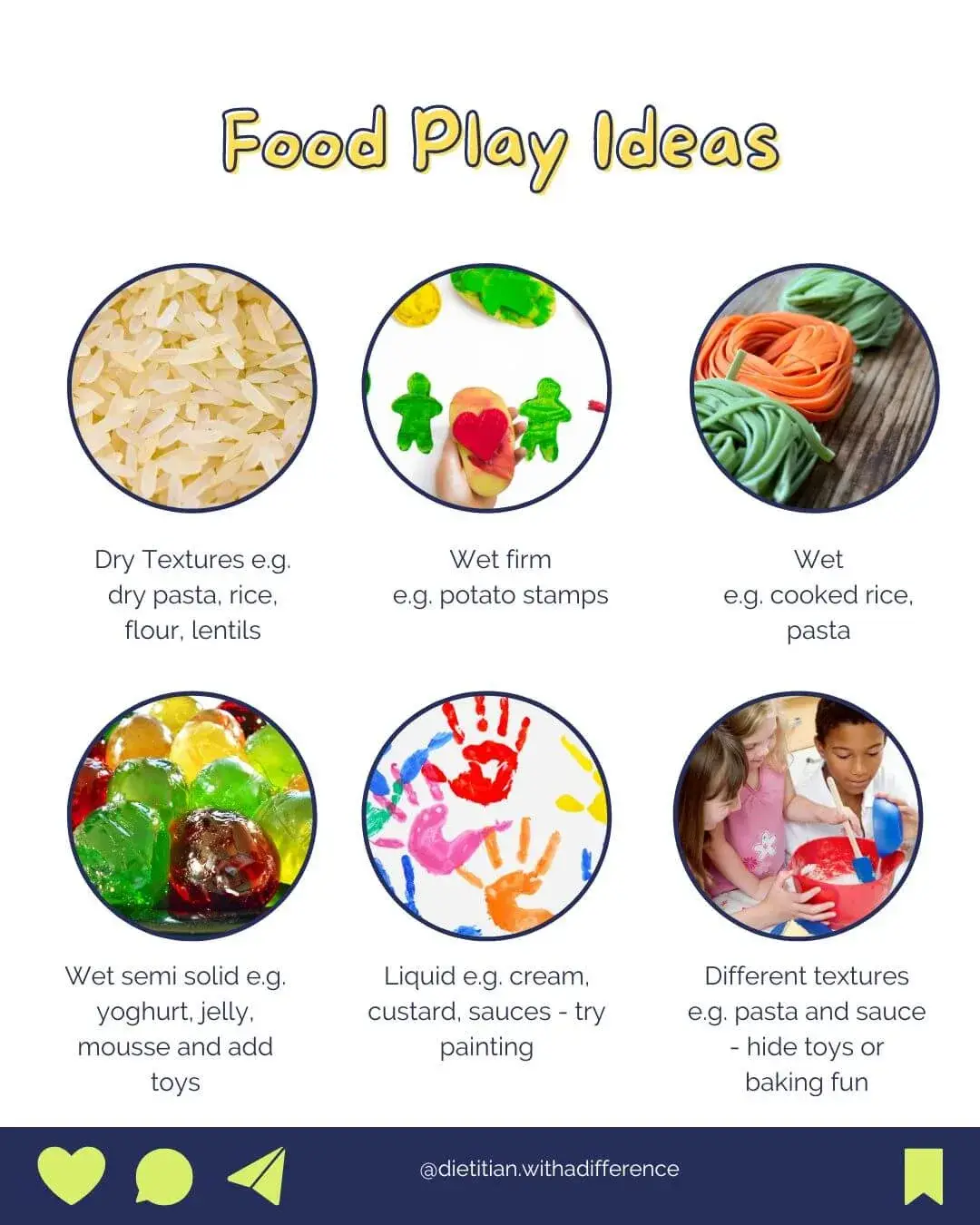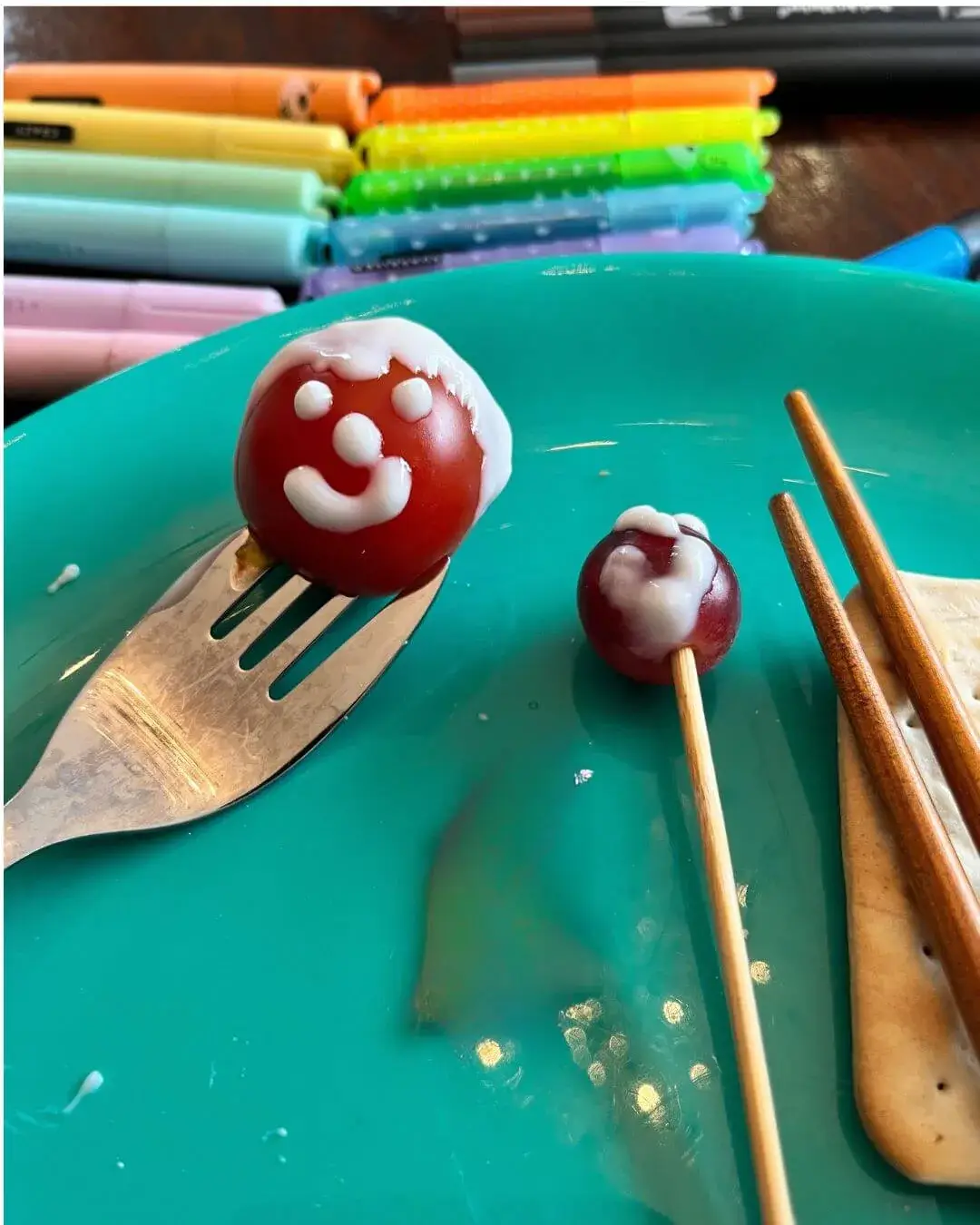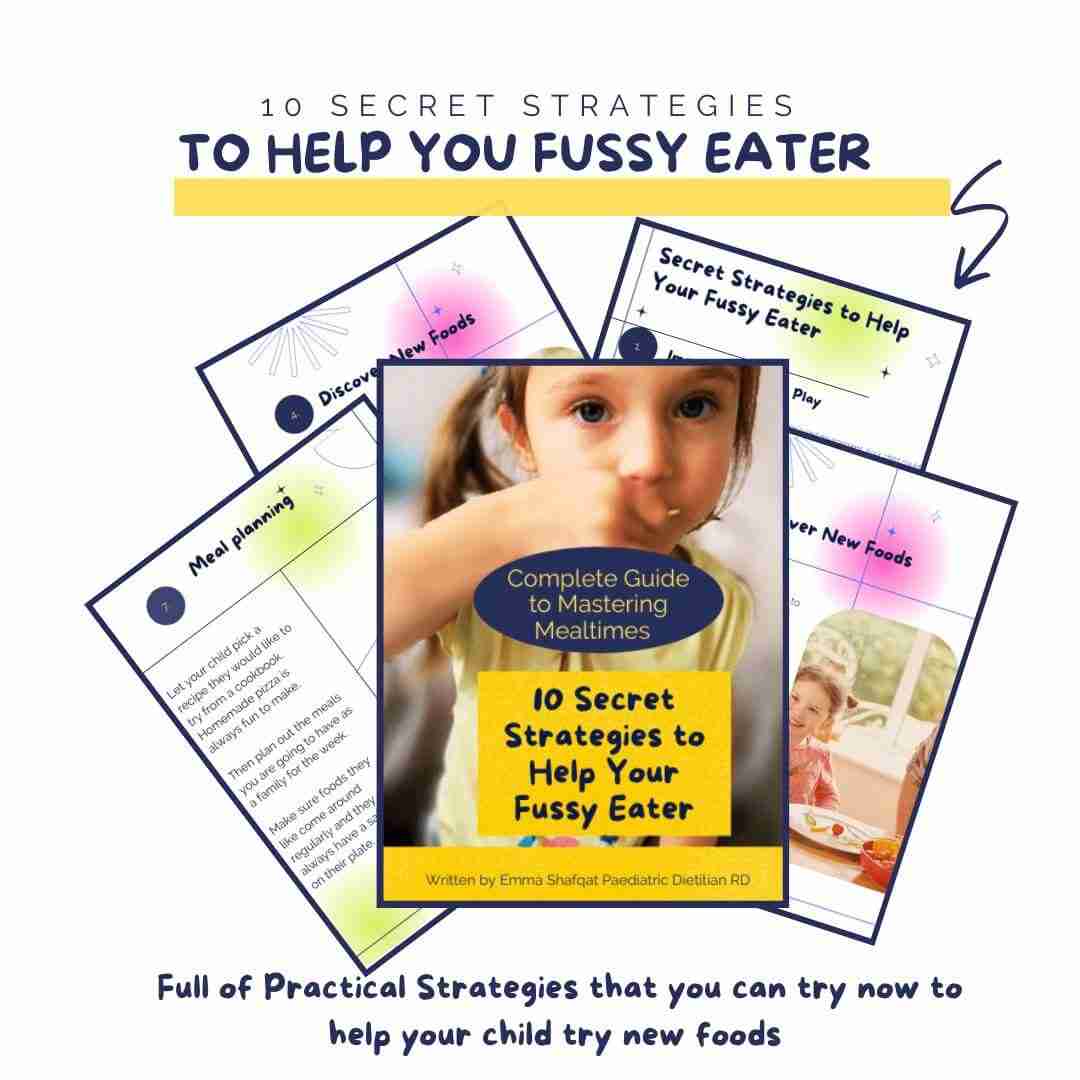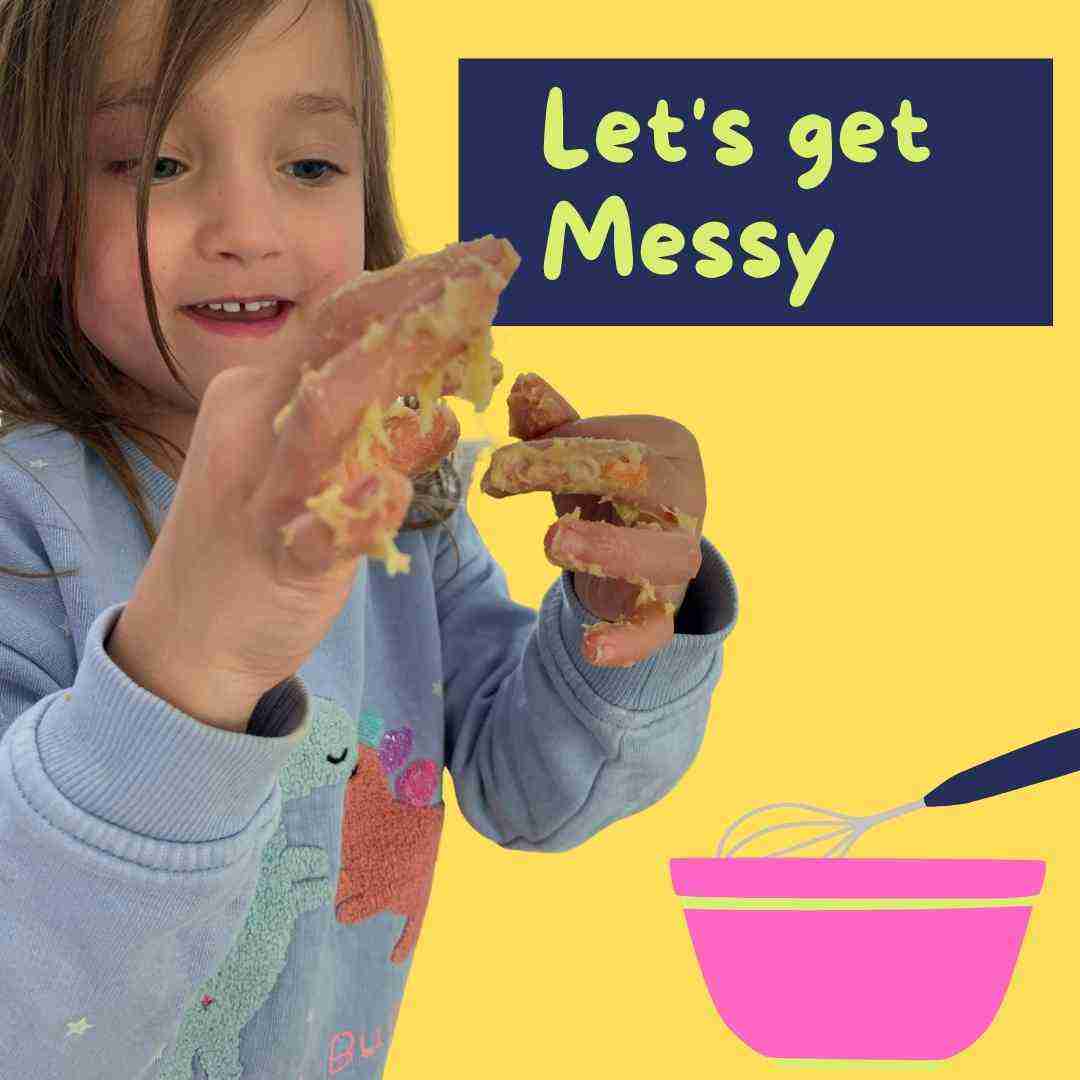Mealtime struggles with picky eaters can often feel like an endless battle, leaving many of us feeling frustrated, defeated, and exhausted.
As a paediatric dietitian and feeding therapist, I’ve encountered countless families grappling with the challenges of raising fussy eaters, including my own.
Having just qualified as an SOS feeding therapist, there was so much talk about the importance of playing with purpose that I wanted to write this blog.
My daughter who suffered from multiple allergies and reflux was understandly hesitant to try new foods, and mealtime were filled with anxiety and tension as she was only on 2nd centile and I worried about her weight.
But I discovered that the more we played and had fun with food the more it increased her chance of trying new foods.
She is at cognitive age often described as being a magical thinker, she found joy and excitement in the fun world of food play, where broccoli became enchanted trees and carrots transformed into fairy wands.
In this blog, I’m thrilled to share with you the magic of food play and how it can revolutionise your journey with picky eaters. Together, we’ll explore a variety of creative solutions tailored for parents struggling with the challenges of fussy eating.
Who Should Engage in Food Play
As parents your involvement is key in sparking your child’s curiosity and excitement for new foods. By jumping into food play activities with enthusiasm, you’ll show your little ones that trying new foods can be fun and adventurous.
Together, we’ll explore how your active participation not only encourages your children to explore new flavours but also fosters positive attitudes towards mealtime.
So, let’s try to embrace the messy (I know it is hard but it will be worth it). Grab your aprons and get ready to embark on this food play adventure with your picky eaters!
What Type of Food Play is helpful
Now that we’ve got our aprons on, let’s delve into the exciting world of food play and discover which activities are perfect for our picky eaters.
We’ll explore specific types of food play that have proven to be particularly effective, such as sensory exploration, food art, and interactive cooking.
From squishing and squeezing playdough to create colourful fruit and vegetable sculptures to turning meal prep into a fun family affair with themed cooking sessions, depending on your child’s age.
I’ll also provide age-appropriate examples and techniques that cater to the preferences and sensitivities of fussy eaters. Whether your little one is a texture avoider or sensory, we’ll find playful solutions to help them expand their culinary horizons.
How does food play work?
Ever wonder why food play feels like magic when it comes to picky eaters? Let’s uncover the secrets behind its effectiveness.
Food play isn’t just about having fun—it’s a powerful strategy for overcoming picky eating behaviours. Studies have shown that sensory play activities when done with fruit and vegetables where more likely to encourage tasting in preschool children than using just visual exposure or non-food play (1).
By engaging in playful exploration, children become more comfortable and familiar with different foods, making them more likely to give them a try. As did you know that there are 32 steps to eating not just two.
One of the fantastic things about food play is its ability to reduce mealtime stress. When mealtime becomes a playful adventure rather than a battleground, both parents and children can relax and enjoy the experience. This relaxed atmosphere encourages children to be more open to trying new foods.
Food play also boosts food acceptance by allowing children to interact with foods in a non-threatening way. Through hands-on activities like sorting, tasting, and creating, children develop a positive relationship with food, making them more willing to explore new flavours and textures.

How to Engage in Food Play
Ready to dive into food play with your picky eaters? Let’s explore some practical strategies to make it part of your daily routines and mealtimes.
First things first, let’s integrate food play into your daily schedule. Start small by incorporating playful elements into snack times or meal prep. Gradually expand to include food play activities during regular meals.
Creating a supportive environment is key to successful food play. Set the stage for exploration by offering a variety of colourful and appealing foods. Encourage curiosity and creativity by providing child-friendly utensils and accessories, such as cookie cutters, silicone molds, and edible markers.
Setting realistic expectations is essential when introducing food play to picky eaters. Remember, progress takes time, so celebrate small victories and be patient with your child’s journey towards trying new foods.
Managing challenges during food play activities is all part of the process. If your child shows resistance or reluctance, try to remain calm and positive. If your child doesn’t want to play today that is fine too.
Above all, remember to have fun! Food play should be an enjoyable and enriching experience for both you and your child. So, let your imagination run wild, and embrace the joy of discovery together.
Food Play for Kids
Get ready to unleash the artist in you and light your picky eater’s imagination with these food play ideas.
Edible Art Gallery
Transform mealtime into a creative masterpiece by encouraging your child to create edible art using a variety of fruits, vegetables, carbohydrates, protein or any other foods they like to try. Arrange sliced fruits and veggies on a plate to form vibrant patterns or let your child build their own masterpiece on whole-grain toast with spreads like hummus or nut butter.
Build-Your-Own Tacos
Turn taco night into a hands-on food play experience! Set out an array of taco ingredients, including protein like grilled chicken or black beans, along with colourful toppings like shredded lettuce, diced tomatoes, and grated cheese. Let your child assemble their own tacos, exploring different flavour combinations and textures.
Sensory Exploration Stations
Create sensory-rich stations where your child can explore food using their senses. Set up stations with various textures, such as crunchy, smooth, and chewy foods. Encourage your child to touch, smell, and taste each food item if they are ready. Remember there should be no pressure to try anything.
Food Art Creations
Encourage your child to get creative with food art projects. Use their favourite shape cutters to transform fruits and vegetables into fun shapes, or turn rice cakes into edible canvases using colourful spreads like yogurt or nut butters.

Storybook Snacks
Bring storytime to life with themed snacks inspired by your child’s favourite books. Create snacks shaped like characters or objects from the story using cookie cutters or molds. As you enjoy the snacks together, encourage your child to retell the story, making mealtime a magical storytelling adventure.
Food Treasure Hunt
Create a treasure map using a piece of paper and mark various “treasure” locations with different foods hidden around the house. Encourage your child to follow the map and discover the hidden treasures.
DIY Snack Creations
Set up a DIY snack station with a variety of ingredients based on your child’s preferences like sliced fruits, vegetables, cheese cubes, whole-grain crackers and try to have a range of all the food groups and textures.
Food-themed Storytelling:
Choose a favourite food-related storybook and use it as inspiration for a themed meal or snack. As you read the story together, pause to enjoy snacks or meals that tie into the plot or characters. Encourage your child to engage in imaginative storytelling while they eat, making mealtime a fun and interactive experience.
Kitchen Science Experiments:
Turn meal prep into a science experiment by exploring how different foods interact with each other. For example, you can create fizzy fruit volcanoes using baking soda and vinegar or make edible slime using ingredients like yogurt and cornstarch. Encourage your child to observe and describe the reactions as they experiment with different food combinations.
Remember, the key is to keep things playful and engaging, allowing your child to explore new foods at their own pace.
In conclusion, as we wrap up our food play adventure, let’s take a moment to reflect on the incredible benefits it offers for picky eaters and their families.
Through the magic of food play, we’ve witnessed firsthand how it can reduce mealtime stress, increase food acceptance, and promote a positive relationship with food for picky eaters.
But beyond the immediate benefits, food play also fosters a sense of joy, creativity, and connection around the dinner table. It transforms mealtime from a battleground into a place of exploration, discovery, and shared experiences.
So, parents, I encourage you to embrace food play as a valuable tool in your arsenal for raising adventurous eaters.
If you like more ideas to help your picky eater try new foods – download 10 secret strategies to help your fussy eater.

Written by Emma Shafqat BSc RD, Dietitian and Nutritionist.
“Dietitian with a Difference” holds no liability for any adverse reactions that may arise from the advice in the blog. The content provided is for informational purposes only and does not replace professional medical advice.



